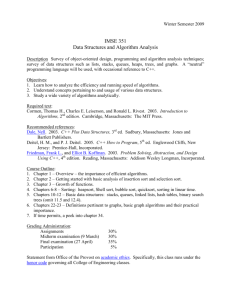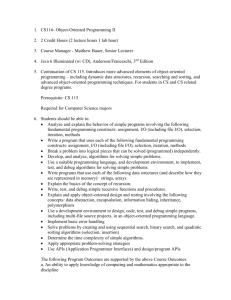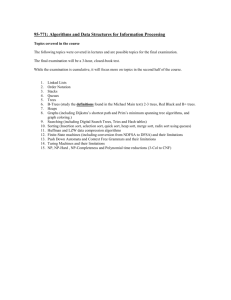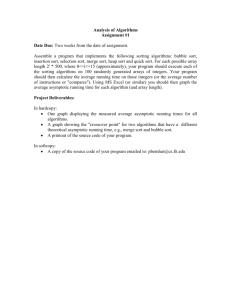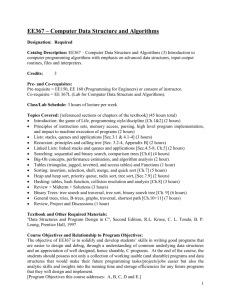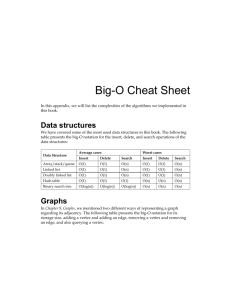Syllabus - Ken Cosh
advertisement
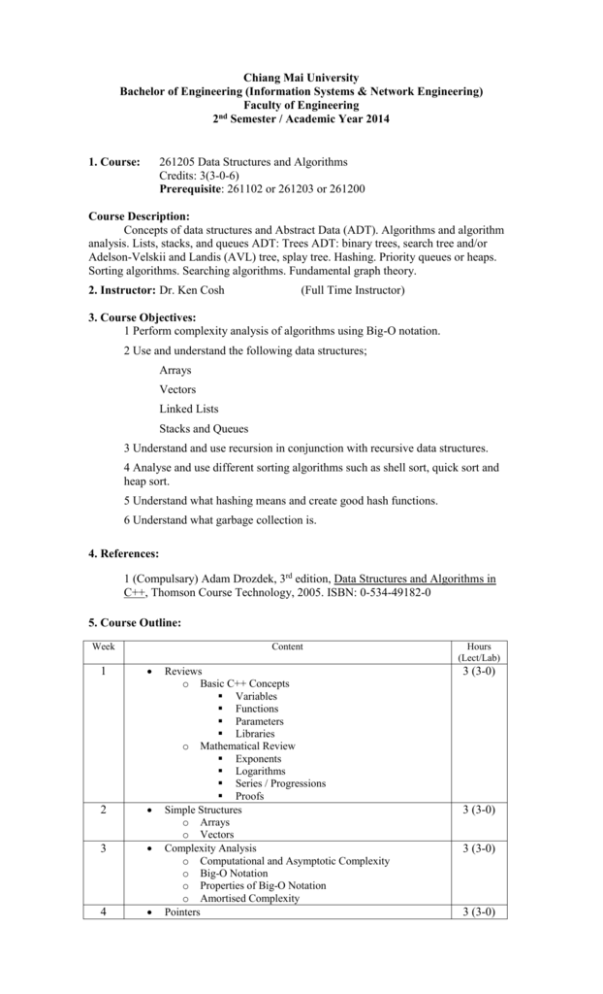
Chiang Mai University Bachelor of Engineering (Information Systems & Network Engineering) Faculty of Engineering nd 2 Semester / Academic Year 2014 1. Course: 261205 Data Structures and Algorithms Credits: 3(3-0-6) Prerequisite: 261102 or 261203 or 261200 Course Description: Concepts of data structures and Abstract Data (ADT). Algorithms and algorithm analysis. Lists, stacks, and queues ADT: Trees ADT: binary trees, search tree and/or Adelson-Velskii and Landis (AVL) tree, splay tree. Hashing. Priority queues or heaps. Sorting algorithms. Searching algorithms. Fundamental graph theory. 2. Instructor: Dr. Ken Cosh (Full Time Instructor) 3. Course Objectives: 1 Perform complexity analysis of algorithms using Big-O notation. 2 Use and understand the following data structures; Arrays Vectors Linked Lists Stacks and Queues 3 Understand and use recursion in conjunction with recursive data structures. 4 Analyse and use different sorting algorithms such as shell sort, quick sort and heap sort. 5 Understand what hashing means and create good hash functions. 6 Understand what garbage collection is. 4. References: 1 (Compulsary) Adam Drozdek, 3rd edition, Data Structures and Algorithms in C++, Thomson Course Technology, 2005. ISBN: 0-534-49182-0 5. Course Outline: Week Content 1 2 3 4 Reviews o Basic C++ Concepts Variables Functions Parameters Libraries o Mathematical Review Exponents Logarithms Series / Progressions Proofs Simple Structures o Arrays o Vectors Complexity Analysis o Computational and Asymptotic Complexity o Big-O Notation o Properties of Big-O Notation o Amortised Complexity Pointers Hours (Lect/Lab) 3 (3-0) 3 (3-0) 3 (3-0) 3 (3-0) 5 6 7 8 9 10 11 12 13 14 15 o Referencing Memory through pointers Introducing Objects & Classes o Simple Objects o Constructors o Accessors o Mutators Introducing Linked Lists o Singly Linked Lists o Doubly Linked Lists o Circular Linked Lists Further Linked Lists o Skip Lists o List Organisation Midterm Review Stacks, Queues & Priority Queues o Stacks o Queues o Priority Queues Recursion o Tail Recursion o Non-Tail Recursion o Indirect Recursion o Nested Recursion o Excessive Recursion Sorting Algorithms o Elementary Sorting Algorithms Selection Sort Insertion Sort Bubble Sort o Efficient Sorting Algorithms Shell Sort Heap Sort Quick Sort Merge Sort Radix Sort Hashing o Efficient Search o Hash Functions Memory Management o Allocating Memory o Garbage Collection String Matching o Brute Force o Hancart Algorithm o Knuth Morris Pratt Algorithm Final Review 3 (3-0) 3 (3-0) 3 (3-0) 3 (3-0) 3 (3-0) 3 (3-0) 3 (3-0) 3 (3-0) 3 (3-0) 3 (3-0) 3 (3-0) 6. Course Activities This course will involve; Lectures Assignments Reading the course material outside of class 7. Course Assessment: 1. Assignments 30% 2. Midterm exam 30% 3. Final exam 40% 8. Course Evaluation: 1. To be able to take the exam students must attend class at least 80% of the time. 2. Plagiarism is not acceptable, any students caught plagiarising will receive 0. 3. The evaluation is based on the grading scale given in the table below: Grade Letter Score (four-point Transcript Grade scale) Legend 80-100 A 4 Excellent 75-79 B+ 3.5 Very Good 70-74 B 3 Good 65-69 C+ 2.5 Quite Good 60-64 C 2 Moderate 55-59 D+ 1.5 Weak 50-54 D 1 Very Weak 0-49 F 0 Fail 4. The following “letter grades” may also be given: “I” Incomplete “W” Withdraw “IP” Course work in progress
